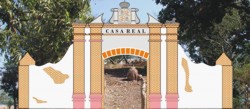 |
1st Capital of Abra |
|
|
|
|
|
 |
1st Capital of Abra |
|
|
|
|
|
|
Casa Real in Bucay is a monumental arch (photo above,) 18m wide by 9m high, complete with columns and capitals, topped by the insignia and crown of the Kingdom of Spain. Built of stone and mortar covered by bricks, it was the gate to a long-gone military fort high on a cliff above the Abra River on the town’s south-eastern end. The fort had to do with the creation of Abra in 1846 as a province segregated from the Ilocos with Bucay as its capital. Other than the monumental arch of today, nothing but a few scattered mounds of bricks and stones remain of the fort (see Plate 15.) The monument is in a very precarious condition after the 1991 earthquake that brought devastation to Baguio and Cabanatuan, showing a crack through the middle of the arch; it could come down crashing, God forbid, on the next typhoon or earthquake. Casa Real is a unique structure that highlights: • The creation of Abra as an independent province in 1846;Following the First International Congress on Fil-Hispanic Architecture, its proceedings saw light in a book with the title Endangered Fil-Hispanic Architecture (Manila, 2002.) 'Endangered' describes very appropriately the elegant XIX-century arch that Bucaeños call Casa Real. It joins a long list of historical architectural structures in the Philippines that, in the words of Instituto Cervantes’ Javier Galvan at the book’s introduction, “are victims of natural calamities, neglect and even of intentional destruction.” Casa Real of Bucay is a good example of the status described by the European Charter of the Architectural Heritage: 6. This heritage is in danger.The importance of the restoration and preservation of Bucay’s Casa Real and its environs can be underestimated only at the risk of a great loss. Every single effort to recover and maintain the icons of the historical heritage of the Philippines becomes crucial for, also in the words of Javier Galvan, this heritage “constitutes a common wealth” and “helps to explain who we are and where we come from.”2 Bucay’s fort is long gone and, what is sadder, forgotten. What was enclosed within its walls has been invaded through time by at least two private residences and a piggery, besides the untrammeled growth of uncontrolled vegetation. Partly because of it, residents of Bucay have a very hazy idea, at best, of what was their Casa Real, its function, or even its historical circumstance. If we add to this the precarious state of conservation of the arch called Casa Real, it is easy to understand why it becomes imperative to institute immediate remedial measures. First, to arrest the worsening state of decay, neglect and legal limbo of the compound; then to revive Bucay’s historic memory; and last to restore wholly or partially the fort to the status and place it deserves in the town. This paper intends to determine the historical facts of Casa Real through research on archival resources existing in the Philippines. The research showcases the following: It is hoped that this paper will not only contribute to make public the history of Bucay, forgotten by the many, but also to provide the ideas that could govern the “recovery” and restoration of the physical elements of its past, its architectural character. ================================ |
||